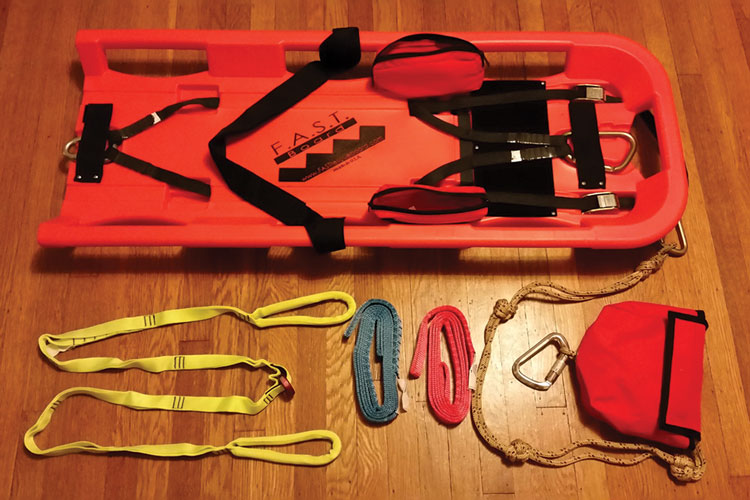
By William Holton
The FAST (Firefighter Assistance Search Team) Board was built for one reason: to save the lives of fellow firefighters, specifically by removing a down firefighter from a basement. Anyone who has ever attempted to move a down firefighter by dragging him across a room and then up a narrow flight of stairs, whether in training or in life-or-death situations, can attest that this is a grueling task.
Eric Allen, a 20-year veteran of the Philadelphia (PA) Fire Department (PFD) with 12 years of experience at Squad 47 (a special operations company), developed a better way to accomplish this task. The PFD has experienced the painful loss of firefighter fatalities too many times. Allen’s concept is to give the rapid intervention team (RIT) a tool to make this task more manageable. The theory combines emergency evacuation with technical rope rescue. After much research, testing, and hard work with trial and error from numerous evolutions, Allen achieved a rescue board that is a complete RIT system. Thus, FAST Rescue Solutions was born.
The beauty of the FAST Board is its simplicity. Roll a down firefighter onto the board face down. The rescuer will then pull the extra-large carabiner at the head of the board, pull the tri-link at the foot of the board between the firefighter’s legs, and make the one-point connection over the firefighter. One connection, one pull. This design is ideal for zero-visibility environments using only your sense of touch. After you make the connection and complete the one pull to tighten the system, the firefighter is ultimately in a harness and ready to be moved.
The lashing used on the FAST Board is made of Kevlar® that is rated at 5,500 pounds and passes the National Fire Protection Association 1983, Standard on Life Safety Rope and Equipment for Emergency Services, heat and flame test. The haul line consists of a 75-foot length of Sterling 7.5mm Escape Tech haul line prerigged to the board; doubled to approximately 25 feet; and knotted every 16 inches for easy-to-find grip points, giving maximum hauling efficiency with gloved hands. This allows for a “down-and-dirty” rapid extrication. The haul system is integrated with the lashing and progress capture systems, allowing for transition from a horizontal drag to a vertical lift without changing the board’s configuration. You can also place a mechanical advantage system anywhere in the haul line, if needed.
 |
| (1) Photo courtesy of FAST Rescue Solutions. |
The FAST Board has a number of unique features. It is 45 inches long, which takes advantage of the body’s natural breaks (hips and knees), allowing for the negotiation of tight corners. There are also 45° front and side undercuts with midpoint rigging at the head of the board, which allows the board to be lifted over obstacles even if the nose gets pushed under an obstacle or under the bullnose of stairs. The 45° side undercuts also allow the FAST Board to ride on its rails to facilitate low radius turns; to combat rollovers from obstructions; and to create a low profile of 13½ inches that will fit between studs that are 16 inches on center, extricating through an improvised wall opening. The sides of the board are raised 3½ inches off the ground, with eight-inch-wide handles that allow for multiple gloved hands to easily lift the patient. There is also a hook-and-loop cross strap that helps secure a RIT kit or medical bag to the board. You will waste no time or effort trying to fasten these mission-critical life safety items.
The primary running surface on the bottom of the FAST Board is 11 inches wide, which means it will fit inside the beams of a ladder, allowing you to use a ground ladder as a track for extrication from a basement or over uneven terrain. The overall width of the FAST Board has been designed to be 18 inches wide, so it will fit inside a Stokes basket or SKED, eliminating the need to transition to other systems.
Although the FAST Board was designed primarily for RIT, it has many other applications. During research and development, we decided to make the board’s components modular and removable for hazmat applications. With a quick reset of the straps, emergency medical services and Special Weapons and Tactics personnel have the ability to easily move multiple patients during mass-casualty incidents. The combination of the board’s length and width and the low-profile position enables effective movement during confined space rescues. The FAST Board’s body and handles are injected with foam so the board will function as a paddle board for water rescue. By adding a cinch collar, it is an effective tool for ice rescue operations.
The FAST Board embodies the next evolution in rescue equipment though an integrated approach to a quick and safe evacuation.
WILLIAM HOLTON is a 10-year veteran of and a firefighter with the Philadelphia (PA) Fire Department and is assigned to Squad 47. He is also a rescue specialist for Pennsylvania Task Force 1.
The Role of the Initial FAST Company
RAPID INTERVENTION TEAMS
Throw Back to Basics: Stokes Basket
Fire Engineering Archives

